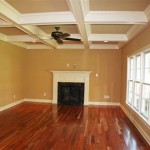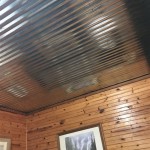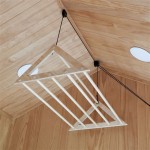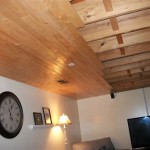Installing a Ceiling Fan on a Cathedral Ceiling: A Comprehensive Guide
Installing a ceiling fan can significantly improve air circulation and energy efficiency in a room. However, installing a ceiling fan on a cathedral ceiling, also known as a vaulted or sloped ceiling, presents unique challenges compared to installing one on a standard flat ceiling. The slope necessitates specific hardware and techniques to ensure the fan hangs safely, operates efficiently, and aesthetically complements the room's design. This article provides a detailed guide on the process, outlining the necessary preparations, tools, and steps involved in successfully installing a ceiling fan on a cathedral ceiling.
Before beginning any electrical work, it's imperative to prioritize safety. Disconnecting power to the circuit you will be working on is non-negotiable. Locate the circuit breaker that controls the existing light fixture or intended fan location and switch it off. To verify that the power is indeed off, use a non-contact voltage tester to confirm no current is flowing through the wires. It is also advisable to have a second person present, especially if you are not experienced with electrical work. Wearing appropriate safety glasses and work gloves is also recommended.
Careful planning and preparation are crucial for a successful installation. This includes assessing the ceiling slope, choosing the correct mounting hardware, and gathering all necessary tools and materials. Neglecting these preliminary steps can lead to complications and potential safety hazards during the installation process.
Assessing the Ceiling and Choosing the Correct Mounting Hardware
The angle of the cathedral ceiling is the primary factor influencing the choice of mounting hardware. The steeper the slope, the longer the downrod needed to ensure adequate clearance between the fan blades and the ceiling. This clearance is essential for optimal airflow and to prevent the fan from wobbling or causing damage. Typically, a ceiling fan will come with a specific downrod, but if the angle of the ceiling is severe, a longer downrod must be purchased separately.
There are primarily two types of mounting methods suitable for cathedral ceilings: angled mounting brackets and flush mount (hugger) fans designed for sloped ceilings. Angled mounting brackets are designed to be installed directly onto the sloped ceiling, and the downrod of the fan is attached to the bracket. These brackets are suitable for less steep slopes. Flush mount fans, on the other hand, are designed to be installed closer to the ceiling, often without a downrod. These are most ideal if space is restricted or for more shallow slopes.
To determine the appropriate downrod length, measure the distance from the ceiling to the desired height of the fan blades. Generally, the blades should be at least 7 feet from the floor. Consult the fan manufacturer's specifications for recommended downrod lengths based on ceiling slope and blade size. It is important to note that using an improper downrod can create safety hazards such as instability and potential falling of the fan. Furthermore, incorrect downrod lengths can negatively effect the fans efficiency.
In addition to the downrod and mounting bracket, ensure that the electrical box in the ceiling is rated for ceiling fan support. Standard electrical boxes are not designed to handle the weight and vibration of a ceiling fan. Replace the existing box with a fan-rated box that is securely attached to a ceiling joist or supporting structure. The new electrical box should be able to support the weight of the fan plus at least an additional safety margin as specified by the local electrical code. Consulting local building codes will also ensure the installation is compliant with all regulations.
Furthermore, it is essential to take into account the size of the room when selecting a ceiling fan. Larger rooms require larger fans to effectively circulate air. Consider the square footage of the room and refer to the fan manufacturer's guidelines to choose a fan with an appropriate blade span. Installing a fan that is too small for the room will result in inadequate air circulation, while a fan that is too large can be overpowering and inefficient.
Gathering Tools and Materials
Before commencing the installation process, gather all necessary tools and materials to ensure a smooth and efficient workflow. Having everything readily available will minimize interruptions and reduce the risk of errors. The following is a comprehensive list of essential tools and materials:
- Ceiling Fan (with all included hardware)
- Fan-Rated Electrical Box
- Angled Mounting Bracket (if required)
- Downrod (appropriate length for ceiling slope)
- Wire Connectors (wire nuts)
- Electrical Tape
- Wire Strippers
- Pliers
- Screwdrivers (Phillips head and flat head)
- Adjustable Wrench
- Voltage Tester (non-contact)
- Ladder (appropriately sized for the ceiling height)
- Drill (with appropriate drill bits)
- Pencil
- Measuring Tape
- Level
- Safety Glasses
- Work Gloves
In addition to these essential items, it may be necessary to have additional wire if the existing wiring is not long enough to reach the fan's wiring connections. Ensure that the wire gauge matches the existing wiring to maintain electrical safety and prevent overheating. If you are unfamiliar with electrical wiring, consulting with a qualified electrician is strongly recommended.
Also, consider the type of ceiling material. If the ceiling is drywall, you may need to use drywall anchors to provide additional support for the mounting bracket. If the ceiling is plaster, special care must be taken to avoid cracking or damaging the plaster during the installation process. Using appropriate drilling techniques and pilot holes can help minimize the risk of damage.
Installation Steps
With the appropriate hardware selected and all necessary tools and materials gathered, the actual installation process can begin. Follow these steps carefully to ensure a safe and successful installation:
- Turn Off the Power: As previously emphasized, always disconnect power to the circuit before working on any electrical wiring. Verify the power is off using a non-contact voltage tester.
- Remove the Existing Fixture: Carefully remove the existing light fixture from the ceiling, taking note of the wire connections. Disconnect the wires using wire strippers and wire nuts.
- Install the Fan-Rated Electrical Box: If the existing electrical box is not fan-rated, remove it and install a new fan-rated box securely attached to a ceiling joist or supporting structure. Ensure the box is properly grounded.
- Install the Mounting Bracket: Attach the angled mounting bracket to the ceiling, aligning it with the electrical box. Use appropriate screws or anchors to secure the bracket to the ceiling joist. Ensure the bracket is level.
- Assemble the Fan Motor: Assemble the fan motor according to the manufacturer's instructions. This typically involves attaching the fan blades and the motor housing.
- Attach the Downrod: Attach the downrod to the fan motor, ensuring it is securely fastened. The downrod should be the appropriate length for the ceiling slope and the desired fan height.
- Hang the Fan: Carefully lift the fan and attach the downrod to the mounting bracket. Ensure the fan is properly seated and secured in the bracket.
- Wire the Fan: Connect the fan's wiring to the electrical box wiring using wire connectors (wire nuts). Typically, there will be a black wire (hot), a white wire (neutral), and a green or bare wire (ground). Match the wires accordingly. Wrap the wire connectors with electrical tape for added security.
- Install the Canopy: Slide the canopy up the downrod to cover the mounting bracket and wiring connections. Secure the canopy to the mounting bracket using the provided screws.
- Install the Light Kit (if applicable): If the fan includes a light kit, install it according to the manufacturer's instructions.
- Install the Fan Blades: Attach the fan blades to the motor housing using the provided screws. Ensure the blades are securely fastened and properly balanced.
- Restore Power: Turn the power back on at the circuit breaker.
- Test the Fan: Test the fan to ensure it is functioning properly. Check all speed settings and the light kit (if applicable).
It is important to double check that all connections are secure before restoring power. Loose connections can cause arcing, overheating, and potentially electrical fires.
Also, be sure to follow the included directions that are packaged alongside the new ceiling fan. While most installations are generally similar, each manufacturer may have their own specific instructions that should be followed for optimal and safest use of the fan.
Troubleshooting a ceiling fan can be difficult. If the fan wobbles excessively, check the blade balance. Most fans come with a balancing kit that includes weights that can be attached to the blades. If these do not fix the wobble, ensure that the fan is securely mounted, and the blades are tightened properly. If the fan does not turn on, check the wiring connections and the circuit breaker. If the light kit does not work, check the bulb and the wiring connections to the light kit.
If you are uncertain about any aspect of the installation process, it is strongly recommended to consult with a qualified electrician. Electrical work can be dangerous, and improper installation can lead to electric shock, fire hazards, and damage to your home. Protect yourself and your property by seeking professional assistance when needed. A licensed electrician can ensure that the installation is performed safely and in compliance with local electrical codes. They can also provide expert advice on choosing the right ceiling fan and mounting hardware for your specific needs.

How To Install A Ceiling Fan On Sloped Lemon Thistle

Cathedral Ceiling Fan Installation Instructions

Ensuring Proper Ceiling Fan Installation With Vaulted Ceilings

How To Choose A Ceiling Fan For Vaulted Ceilings Lightology

Fan And Fixture Box For Cathedral Ceilings

How To Install Vaulted Ceiling Fan

Installing Ceiling Fans On Cathedral Ceilings Mr Electric Of Dallas

How To Properly Install A Fan If You Have Cathedral Ceiling

How To Choose A Ceiling Fan For Vaulted Ceilings Lightology

How To Choose A Ceiling Fan For Vaulted Ceilings Lightology
Related Posts








